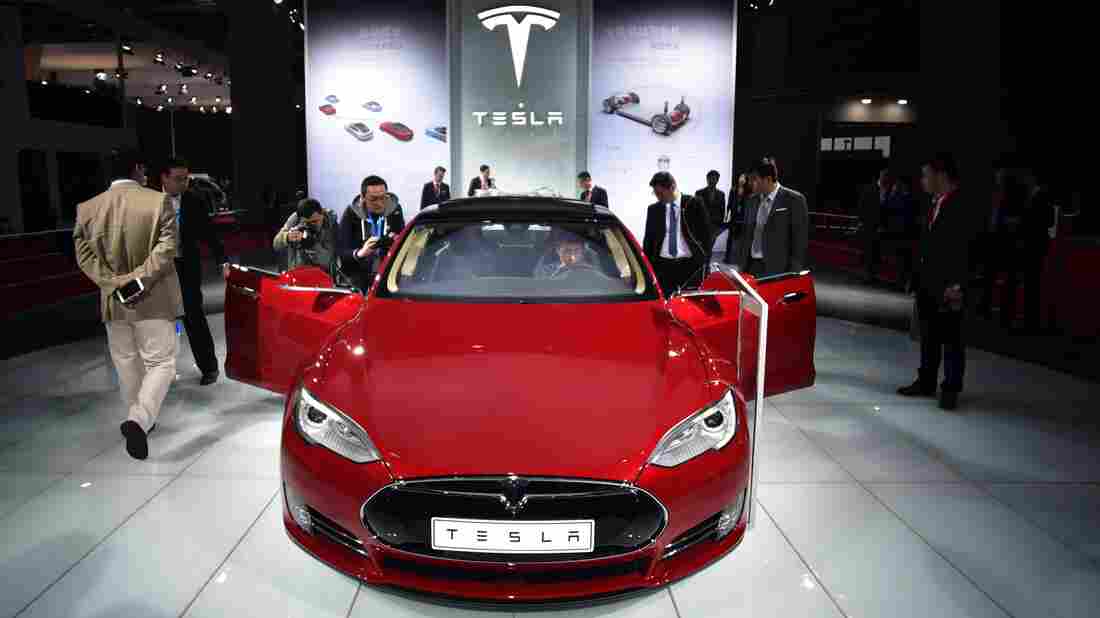Tesla’s Model S P85D, seen here at a car show in April, scored 103 on Consumer Reports’ 100-point ratings system. Johannes Eisele/AFP/Getty Images hide caption
itoggle caption Johannes Eisele/AFP/Getty Images
With a rare mix of blazing speed, safety and energy efficiency, the new Tesla Model S P85D left the folks at Consumer Reports grasping for ways to properly rate the car, after it scored a 103 — out of 100. “It kind of broke the system,” says Jake Fisher, director of the magazine’s auto test division.
Listing the all-electric car’s attributes, including its improved handling and stopping power, Fisher says, “We’re seeing numbers that we haven’t seen before. So this kind of blew out the system. We’re giving it a score of 100.”
That final rating came after the product testing organization adjusted its metrics a bit (but it says it won’t now grade all other cars on the P85D’s curve). It posted the results online Thursday — and in a rare move, Consumer Reports didn’t require a subscription to see the Tesla ratings (that move very likely played a part in the company’s trouble with its Web servers).
In a video discussion of the Model S P85D, Fisher says, “We’re not used to seeing large cars go 0-60 in 3.5 seconds. We’re not used to seeing large cars that get an equivalent of 87 miles per gallon, and are that fast. So it really blows apart a lot of things.”
Consumer Reports’ experts note that the score doesn’t mean the car has achieved perfection — for one thing, there’s the $127,820 price tag of the tested model. That makes it the most expensive car that the magazine has ever tested. And then there’s the base model’s estimated range of about 250 miles on a single charge.
But the magazine’s autos editor, Mark Rechtin, also notes that the Tesla is impressive for its quickness in applying power to the road — and pushing its occupants back in their seats.
“This car goes from 0 to 1.02 G’s in less than a quarter of a second,” Rechtin says, “which is almost as fast as the human brain can react.”
That rush of speed happens silently, Rechtin added. He said, “The only other way that you can feel that, in a legal setting, is to basically jump out of an airplane.”
We’ll note that those speeds reflect a car outfitted with the “Insane” driving mode. The quicker “Ludicrous” mode gets to 60 mph in 2.8 seconds, according to Tesla.
The glowing review generated intense interest in the car Thursday (as of this writing, the Consumer Reports website has crashed); it also propelled Tesla’s stock to an 8 percent gain, to a close of $242.99 on the Nasdaq market. That’s quite a bounce for a stock that, at the opening of Monday’s trading session, could be had (briefly) for $202.
On the performance of Tesla’s stock, The Wall Street Journal notes, “at midday, Tesla’s market value stood at $31.7 billion, up $2.5 billion from Wednesday’s close.”
In its first years in the auto market, Tesla has focused on high-priced cars. The Model S cost more than $50,000 when it was introduced, and the new Model S P85D has a base price of $104,500. But earlier this year, the company announced plans to produce a more affordable car called the Model 3, with a list price of $35,000.
This entry passed through the Full-Text RSS service – if this is your content and you’re reading it on someone else’s site, please read the FAQ at fivefilters.org/content-only/faq.php#publishers.
